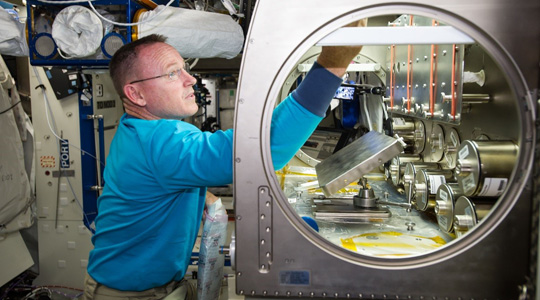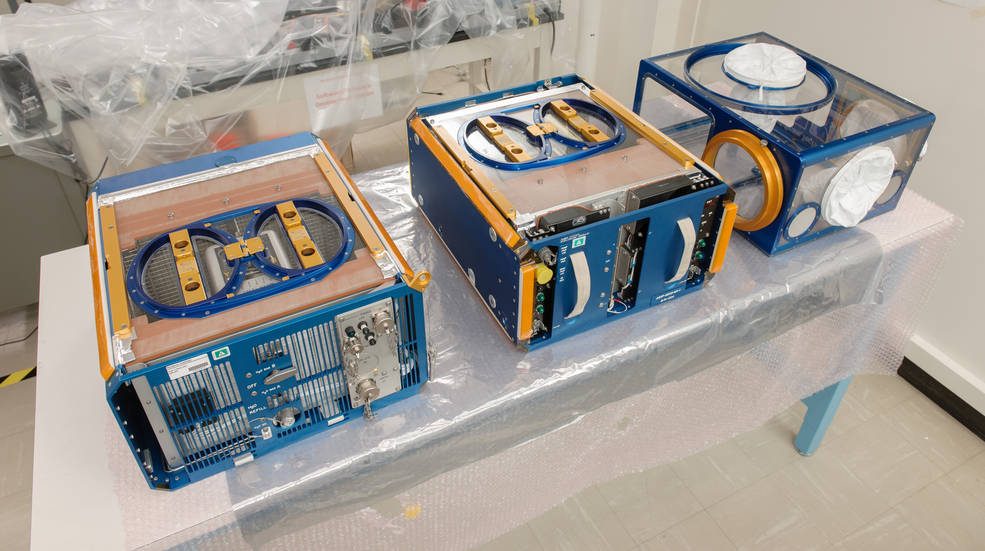
Although abnormal effects of microgravity during rocket flights were noted as early as 1952, in-depth research in this area didn’t begin in earnest until the in the early 90s with short flights orbiting Earth aboard various space transporter shuttle (STS) missions. Unfortunately, opportunities to extend this research have been limited since the Space Shuttle program was shut down in 2011. With the completion of the International Space Station Rodent Research Facility in the spring of 2014, however, there is renewed excitement for current and future studies that will look at long-term effects of space travel in mouse models housed in space for up to six months - the equivalent of approximately 40 human years - at a time.
Space biology then
For over 20 years research using mice in space was done during short flights aboard a number of different space shuttles, beginning with Columbia launched in 1991 and concluding with the final flight of the Space Shuttle Program aboard Atlantis in 2011. In these missions, mice were housed in a Spacelab Life Sciences with a Microgravity Laboratory module, and different strains of mice were observed while orbiting the earth for up to two weeks at a time. NASA also collaborated with Russian crew and scientists from the Institute for Biomedical Problems of the Russian Academy of Sciences on a series of uncrewed missions (called Foton and Bion) into space that carried a variety of rodent and other non-human biological experiments into space.
Data from these missions gave scientists insights into the rapid degenerative effects of spaceflight. It turns out that without gravity, cells, molecules, microbes, and space travelers’ physiologies rapidly change in ways that pose risks for space exploration. Bone and muscle loss, reduced cardiovascular capacity, defects in wound and bone fracture healing, and impaired immune function occur very rapidly when either animal models such as B6J mice or humans travel in space.
Fortunately, space researchers are starting to get to the root of these problems. NASA scientist Dr. Eduardo Almeida, who joined NASA’s Ames Research Center in Silicon Valley in 2001, began wondering if the problem astronauts experience with delayed wound healing, bone and muscle loss, and decreased immune function had something to do with unhealthy stem cells and tissue regeneration in microgravity. Aboard the Foton M2 and M3 Russian missions, he studied the ability of newts (a type of amphibian) to regenerate limbs in microgravity, in collaboration with the Institute for Biomedical Problems of the Russian Academy of Sciences. Newts with amputated tails are able to regenerate them on Earth, but the team found that they did not regenerate normally in space. The problem was that cells wouldn’t transition from stem cells to the differentiated cells that produce all the specialized tissues of the tail, such as muscle, nerves, and blood vessels.
Men and women are not newts, but we still have several crucial populations of stem cells that are absolutely required for bone maturation and regeneration and for hematopoiesis that generates the vast numbers of red blood cells and cells that are part of both the adaptive and the innate immune systems.
It’s like gravity uncorks or unblocks the transition from undifferentiated stem cells to a much needed variety of mature cells. Similar to the newts exposed to microgravity, C57BL/6J mice flown aboard the Space Shuttle had bone marrow cells that could not differentiate into osteocytes, a necessary step for bone regeneration. On top of that, hematopoietic stem cell differentiation also was inhibited by microgravity, as evidenced by the down-regulation of several gene expression markers and the accumulation of undifferentiated progenitor cells.
Moving therapies from the lab to the medicine cabinet takes time, as did the progression of these studies, which spanned a decade of STS missions while the space station was under construction. However, experiments managed by NASA’s Ames Research Center have identified paths for developing countermeasures for longer-duration human spaceflight.
Bioastronautics now
With the International Space Station (ISS) fully operational, the unique laboratory in space is now “open for business.” To support biological research on ISS, NASA has developed a new suite of hardware to support rodent research, leveraging the equipment designs that evolved from the Space Shuttle era. The ISS is the first “permanent” orbiting science laboratory that offers the chance of doing longer-term experiments in space compared to what could be accomplished in shuttle missions, increasing data collection and the potential for discovery during experiments spanning many weeks and months. Two experiments focused on drug discovery have been completed and more experiments are in the queue to be launched in the coming months.
The new NASA Rodent Research facility has self-contained rodent habitats that provide its occupants living space, food, water, ventilation, and lighting.

Figure 1. The Rodent Research Hardware System includes three modules: a Habitat (left), where up to 10 mice can easily move around the living space by grasping grids that line the floor and walls, a Transporter (center), used for launching live animals, the Animal Access Unit (right), which allows the crew to access to animals on board the ISS and their transfer from one unit to another. (Image courtesy of NASA).
Scientists at NASA’s Ames Research Center are also developing a Bioculture System for culturing human and animal cell lines and the WetLab-2 system, capable of performing qRT-PCR on multiple sample types ranging from microbial cultures to animal tissues dissected on-orbit. The ability to conduct qRT-PCR in orbit eliminates the confounding effects that reentry stresses and shock place on gene expression and the physiology of live cells and organisms and the chances for RNA degradation in prepared samples.
The validation of the WetLab-2 system was depending on its delivery to the ISS in the SpaceX-7 mission on June 28, 2015. Unfortunately, the private American rocket cargo mission contracted to NASA failed that day, disintegrating less than 3 minutes into the launch. Luckily, the mission had no crew, and NASA is re-building the lost equipment and restocking lyophilized reagents for a number of kits. It is hoped that the next mission to send the modules to the ISS will be scheduled by the end of the year.
Epic microgravity studies are not only important for protecting the health of astronauts embarking on long-term space missions, but they are also helping to develop treatments for diseases on Earth: spaceflight-induced changes in bones and the immune system recapitulate common diseases such as osteoporosis and immune suppression.
As Dr. Alemida’s group is working around-the-clock to analyze and roll out their new data collected from 5 other microgravity experiments moving the space biology field forward, there is great hope that their findings will also lead to therapeutic solutions to bone and muscle atrophy and dramatic loss of strength seen in most bedridden patients on Earth.